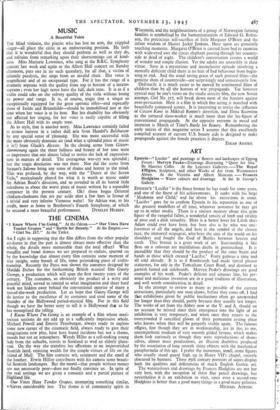ART
Epstein—" Lucifer" and paintings of flowers and landscapes of Epping Forest: Mervyn Peake—Drawings illustrating "Quest for Sna." By Maurice Collis. At the Leicester Galleries.—The Royal Effigies, Sculpture, and other Works of Art from Westminster Abbey. At the Victoria and Albert Museum. — Frances Hodgkins — Water colours and drawings. At the St George's Gallery.
Emotes `Lucifer' is the finest bronze he has made for some years, and one of the finest of his achievements. It ranks with his large ' Madonna and Child,' and far above his excursions in stone. `Lucifer' goes far to confirm Epstein in his reputation as one of the greatest modellers of all time, whatever nonsense he may get up to in other media. There is a sinister majesty about this grim figure of the vengeful fallen, a wonderful tensity of limb and vitality of pose and a dark sexuality. Here is a better lover for Lilith than Adam could ever have been, but here also is he who was ono- foremost of all the angels, and here is the symbol of the chosen race, the immortal scapegoat, who bore the sins of the world on his shoulders and fought the God of Battles between heaven and earth. This bronze is a great work- of art. Surrounding it like fleas on a colossus are multifarious daubs in postercolour. It is incredible that they should be the product of the same brain and hands as those which created 'Lucifer.' Forty guineas a time and all sold already. It is as if Rembrandt had made tinted plaster statuettes, for sale in. the Tottenham Court Road, and destined to garnish fumed oak sideboards. Mervyn Peake's drawings are good examples of his work. Peake's delicate and sinuous line, his per- sonal and malicious invention are in a good tradition of illustration, and well worth consideration in detail.
In fthe attempt to review as many as possible of the current attractions, particularly one man shows, before they come off, I find that exhibitions given by public institutions often go unrecorded for longer than they should, partly because they usually last longer. The works of art from the Abbey now at the V. and A. should on no account be missed since their emergence into the light of an exhibition is very temporary, and when once they return to the overcrowded if sanctified gloom of their permanent resting place who knows when they will be properly visible again. The famous effigies, fine though they are in workmanship, are in the, to me, unsympathetic medium of very smooth gilded bronze, which makes them look curiously as though they were reproductions of them- selves, almost mass productions, an illusion doubtless produced by the association of long smooth shiny objects with the mechanical paraphernalia of this age. I prefer the numerous, smell, stone figures who usually stand guard high up in Henry VII's chapel, entirely obscured by banners. These rsth century portraits of saints display both the qualities and deficiencies of much English Gothic art.
The watercolours and drawings by Frances Hodgkins are not her very best, with the exception of three fine pencil drawings, but nevertheless it is an exhibition to visit, since even a second-rate Hodgkins is better than a good many things in a good many galleries.
MICHAEL AYRTON.


























 Previous page
Previous page